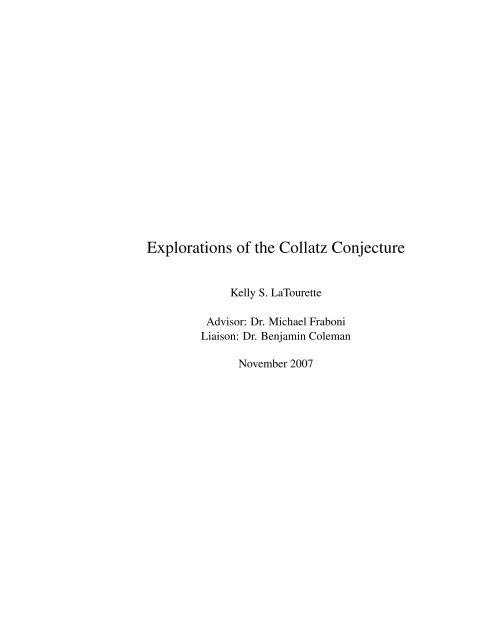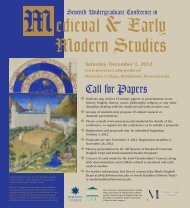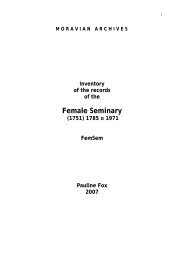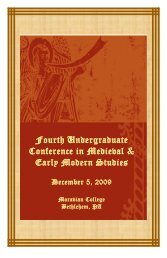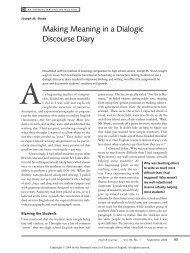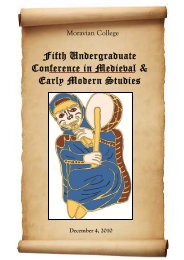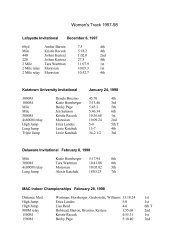Explorations of the Collatz Conjecture - Moravian College
Explorations of the Collatz Conjecture - Moravian College
Explorations of the Collatz Conjecture - Moravian College
You also want an ePaper? Increase the reach of your titles
YUMPU automatically turns print PDFs into web optimized ePapers that Google loves.
<strong>Explorations</strong> <strong>of</strong> <strong>the</strong> <strong>Collatz</strong> <strong>Conjecture</strong><br />
Kelly S. LaTourette<br />
Advisor: Dr. Michael Fraboni<br />
Liaison: Dr. Benjamin Coleman<br />
November 2007
Abstract<br />
This paper presents results found from work on total stopping times <strong>of</strong> <strong>the</strong> <strong>Collatz</strong><br />
<strong>Conjecture</strong>. We are especially interested in when <strong>the</strong> total stopping times <strong>of</strong><br />
consecutive integers are equal, why <strong>the</strong>y are equal, and finding runs <strong>of</strong> consecutive<br />
integers that have equal total stopping time. We use special parity sequences<br />
known as blocks, strings and stems to study <strong>the</strong> behaviors <strong>of</strong> <strong>the</strong> trajectories <strong>of</strong><br />
<strong>the</strong>se integers. Our work culminates in <strong>the</strong> conjecture that given any starting parity<br />
sequence, we can construct an arbitrarily long run <strong>of</strong> consecutive integers <strong>of</strong><br />
<strong>the</strong> same total stopping time.
Dedication<br />
This project is dedicated to my mo<strong>the</strong>r. She is my motivation to work hard, my<br />
role model for treating o<strong>the</strong>rs with kindness, my inspiration to never lose hope<br />
and my guardian angel that is watching over me every day. I love and miss you<br />
dearly, Mom!<br />
1
Acknowledgments<br />
A HUGE thank you goes out to:<br />
• Dr. Michael Fraboni, not just my academic advisor, but my friend as well.<br />
You believed in me when I had difficulty believing in myself. You have<br />
always cared not just about me as a student, but also about me as a person.<br />
Thank you for everything.<br />
• My SOAR Team: Dr. Alicia Sevilla, Rebecca Angstadt and James Long.<br />
You were all a terrific help throughout our summer <strong>of</strong> research and your<br />
continued support as this became my Honors Project has been wonderful.<br />
I’m glad that we got to spend those countless hours discussing 3x + 1 for a<br />
whole summer. Thank you!<br />
• Patrick Sutton, my friend and Writing Center Tutor. Thank you for your<br />
many hours <strong>of</strong> reading drafts <strong>of</strong> this paper and for knowing just what to say<br />
to make me laugh when <strong>the</strong> going got tough.<br />
• My wonderful family. Thanks for all <strong>of</strong> <strong>the</strong> support and encouragement<br />
in helping me fulfill my goals <strong>of</strong> becoming a successful college student.<br />
Knowing that I had your love with me always helped me through.<br />
• My amazing friends, Andrew Abraham, Katie Bernstein, Jessica Fenske,<br />
Timothy Mills, Wesley Moser, Christopher Schilling, Rachael Todd, my<br />
Gamma Sigma Sigma bro<strong>the</strong>rs and sisters and all <strong>of</strong> <strong>the</strong> SOAR kids: You<br />
have all gone above and beyond <strong>the</strong> call <strong>of</strong> duty. You have encouraged me,<br />
helped me relax, and were <strong>the</strong>re when I just needed someone to talk to. You<br />
are a truly fantastic group <strong>of</strong> friends and I am blessed to have you.<br />
• My pr<strong>of</strong>essors: Dr. Benjamin Coleman, Dr. Kevin Hartshorn, Dr. Robert<br />
Mayer and Dr. Nathan Shank: Thank you all so much for your kindness,<br />
understanding and support. Having pr<strong>of</strong>essors like you is what makes me<br />
love learning here at <strong>Moravian</strong> so much!<br />
2
Preface<br />
It all began as a research project in <strong>the</strong> Student Opportunities for Academic Research<br />
(SOAR) Program in <strong>the</strong> summer <strong>of</strong> 2006. Along with students Rebecca<br />
Angstadt and James Long, as well as Drs. Michael Fraboni and Alicia Sevilla,<br />
I delved deep into <strong>the</strong> complexities <strong>of</strong> <strong>the</strong> <strong>Collatz</strong> <strong>Conjecture</strong>. For 10 weeks we<br />
met day after day to discuss our findings and our struggles as we tried to make<br />
some sense out <strong>of</strong> pieces <strong>of</strong> <strong>the</strong> conjecture. Rebecca turned her focus toward <strong>the</strong><br />
negative integers and <strong>the</strong> three known cycles found through function iterations<br />
<strong>the</strong>re. James, on <strong>the</strong> o<strong>the</strong>r hand, spent much <strong>of</strong> his time analyzing <strong>the</strong> work <strong>of</strong><br />
Riho Terras and <strong>the</strong>n eventually applying it to generalizations <strong>of</strong> our function. I<br />
set my sights on <strong>the</strong> total stopping times <strong>of</strong> <strong>the</strong> integers and constructing a massive<br />
graphical representation <strong>of</strong> <strong>the</strong> function. I enjoyed my work and was so intrigued<br />
by <strong>the</strong> conjecture that I have expanded my research into <strong>the</strong> Honors Project that<br />
is in front <strong>of</strong> you now. I hope that you enjoy reading it as much as I have enjoyed<br />
working on it.<br />
3
Contents<br />
1 Introduction 6<br />
1.1 Definitions . . . . . . . . . . . . . . . . . . . . . . . . . . . . . . 7<br />
2 Total Stopping Time 10<br />
3 Consecutive Integers 14<br />
3.1 Applying Garner’s Stems . . . . . . . . . . . . . . . . . . . . . . 19<br />
3.2 Consecutive Triples . . . . . . . . . . . . . . . . . . . . . . . . . 21<br />
4 Blocks and Strings 23<br />
4.1 Corresponding Blocks and Strings . . . . . . . . . . . . . . . . . 23<br />
4.2 Block and String Structure . . . . . . . . . . . . . . . . . . . . . 29<br />
4.2.1 Equal number <strong>of</strong> ones . . . . . . . . . . . . . . . . . . . 29<br />
4.2.2 Difference Between Sums . . . . . . . . . . . . . . . . . 29<br />
4.2.3 Switching 0’s and 1’s . . . . . . . . . . . . . . . . . . . . 31<br />
4.2.4 Proportion <strong>of</strong> Ones . . . . . . . . . . . . . . . . . . . . . 36<br />
5 Long Runs <strong>of</strong> Consecutive Integers 41<br />
4
6 Future Work 45<br />
A Branch Count Procedure 47<br />
Bibliography 49<br />
5
Chapter 1<br />
Introduction<br />
The <strong>Collatz</strong> <strong>Conjecture</strong> is a well-known problem that has been puzzling ma<strong>the</strong>maticians<br />
for years. The conjecture was first proposed in 1937 by Lothar <strong>Collatz</strong>,<br />
a German ma<strong>the</strong>matician. Since <strong>the</strong> 1930’s it has been studied in a variety <strong>of</strong><br />
ways by ma<strong>the</strong>maticians all over <strong>the</strong> world. It has received o<strong>the</strong>r names, such as<br />
<strong>the</strong> Hailstone Numbers, <strong>the</strong> 3x+1 Problem, <strong>the</strong> Ulam <strong>Conjecture</strong> and <strong>the</strong> Syracuse<br />
Problem, from <strong>the</strong> various ma<strong>the</strong>maticians who have studied it. The past 70 years<br />
have led to <strong>the</strong> discovery <strong>of</strong> many different properties, extensions and representations<br />
<strong>of</strong> <strong>the</strong> basic idea <strong>of</strong> <strong>the</strong> conjecture. For a nice overview <strong>of</strong> work that has been<br />
done on <strong>the</strong> <strong>Collatz</strong> <strong>Conjecture</strong>, see The 3x+1 problem and its generalizations by<br />
Jeffrey Lagarias [5].<br />
Lagarias worked with David Applegate [1, 2] to develop <strong>the</strong>ir own ideas and<br />
<strong>the</strong>ories on <strong>the</strong> problem. Their work on trees and total stopping time was <strong>of</strong> special<br />
interest to me, as we will see later on in this paper.<br />
Ano<strong>the</strong>r ma<strong>the</strong>matician whose work was especially helpful, was Riho Terras<br />
[6]. He developed an algorithm that I used again and again throughout my re-<br />
6
search. Most <strong>of</strong> my work, however is an extension <strong>of</strong> work specifically done by<br />
Lynn Garner in On heights in <strong>the</strong> <strong>Collatz</strong> 3n+1 problem [4]. This work focuses on<br />
<strong>the</strong> heights (total stopping times) <strong>of</strong> integers. Guo-Gang Gao [3] produced work<br />
similar to Garner’s, but worked with a slightly different function than <strong>the</strong> one that<br />
we used.<br />
For <strong>the</strong> purposes <strong>of</strong> this research, we will use <strong>the</strong> representation that is typically<br />
known as <strong>the</strong> 3x + 1 function and is defined as follows.<br />
For all positive integers x,<br />
⎧<br />
x<br />
⎪⎨ if x is even<br />
2<br />
T(x) = ⎪⎩ 3x+1<br />
if x is odd .<br />
2<br />
The 3x + 1 conjecture states that all positive integers, when repeatedly iterated<br />
through this function, will enter <strong>the</strong> 2-1 cycle. We say that <strong>the</strong> integers one and<br />
two form a cycle because T(1) = 2 and T(2) = 1.<br />
1.1 Definitions<br />
In order to fur<strong>the</strong>r this discussion <strong>of</strong> <strong>the</strong> conjecture, we must define a few terms<br />
that are commonly used when discussing this problem. The trajectory <strong>of</strong> an integer<br />
is <strong>the</strong> sequence that <strong>the</strong> integer follows through <strong>the</strong> 3x + 1 function. The<br />
trajectory <strong>of</strong> x can be represented as 〈x, T 1 (x), T 2 (x), ...〉. Then, ano<strong>the</strong>r way to<br />
state <strong>the</strong> conjecture is that all positive integers have trajectories that contain two.<br />
Therefore, we usually look at <strong>the</strong> trajectory entries just up to <strong>the</strong> first occurrence<br />
<strong>of</strong> two. For example, <strong>the</strong> trajectory <strong>of</strong> 11 is 〈11, 17, 26, 13, 20, 10, 5, 8, 4, 2〉 and<br />
<strong>the</strong> trajectory <strong>of</strong> 27 is 〈27, 41, 62, 31, 47, 71, 107, 161, 242, 121, 182, 91, 137,<br />
7
206, 103, 155, 233, 350, 175, 263, 395, 593, 890, 445, 668, 334, 167, 251, 377,<br />
566, 283, 425, 638, 319, 479, 719, 1079, 1619, 2429, 3644, 1822, 911, 1367,<br />
2051, 3077, 1616, 2308, 1154, 577, 866, 433, 650, 325, 488, 244, 122, 61, 92,<br />
46, 23, 35, 53, 80, 40, 20, 10, 5, 8, 4, 2 〉. Using <strong>the</strong> trajectory, we can obtain <strong>the</strong><br />
parity vector <strong>of</strong> an integer.<br />
Simply put, <strong>the</strong> entries <strong>of</strong> <strong>the</strong> parity vector are <strong>the</strong> elements <strong>of</strong> <strong>the</strong> trajectory<br />
reduced mod 2. We used <strong>the</strong> notation P n (x) to denote <strong>the</strong> first n elements <strong>of</strong> <strong>the</strong><br />
parity vector <strong>of</strong> x. We will call this <strong>the</strong> partial parity vector <strong>of</strong> length n. For<br />
example, P 10 (11) = 〈1, 1, 0, 1, 0, 0, 1, 0, 0, 0〉.<br />
The total stopping time σ ∞ (x) <strong>of</strong> a positive integer x is defined to be <strong>the</strong> number<br />
<strong>of</strong> iterations needed for that integer to reach one, or ∞ if <strong>the</strong> trajectory <strong>of</strong> x<br />
does not contain one. In Chapter 2 we investigate <strong>the</strong> total stopping time through<br />
<strong>the</strong> construction <strong>of</strong> a graphical representation <strong>of</strong> <strong>the</strong> function, which is called a<br />
tree. This tree is based upon <strong>the</strong> inverse map <strong>of</strong> our function and helps us visualize<br />
<strong>the</strong> function. It also led us to identify several patterns found throughout <strong>the</strong><br />
integer trajectories.<br />
In Chapter 5, we define a run to be a set <strong>of</strong> consecutive integers that all have<br />
<strong>the</strong> same total stopping time. In order to study <strong>the</strong>se runs we look at some special<br />
parity sequences known as blocks, strings and stems. We will define corresponding<br />
stems to be a pair <strong>of</strong> parity sequences <strong>of</strong> length k such that if two consecutive<br />
integers have parity vectors that begin with this pair, <strong>the</strong>n after k iterations, <strong>the</strong>ir<br />
trajectories merge. See Definition 1 in Chapter 3 for a precise definition.<br />
On <strong>the</strong> o<strong>the</strong>r hand, we will define corresponding blocks and corresponding<br />
8
strings to be pairs <strong>of</strong> parity sequences <strong>of</strong> length k such that if two consecutive<br />
integers have parity vectors that begin with this pair, <strong>the</strong>n after k iterations <strong>the</strong> next<br />
entries in <strong>the</strong>ir trajectories are consecutive. See Definitions 2 and 4 in Chapter 4<br />
for fur<strong>the</strong>r explanation. We use <strong>the</strong>se parity sequences as a tool for investigating<br />
<strong>the</strong> behavior <strong>of</strong> <strong>the</strong> 3x + 1 function, including finding long runs <strong>of</strong> consecutive<br />
integers.<br />
Finally, in Chapter 6, we discuss what <strong>the</strong> future might hold for fur<strong>the</strong>r research<br />
on <strong>the</strong> total stopping times <strong>of</strong> <strong>the</strong> <strong>Collatz</strong> <strong>Conjecture</strong>.<br />
9
Chapter 2<br />
Total Stopping Time<br />
Recall that <strong>the</strong> total stopping time σ ∞ (x) <strong>of</strong> a positive integer x is defined to be <strong>the</strong><br />
number <strong>of</strong> iterations needed for that integer to reach one. In order to get a better<br />
visual representation <strong>of</strong> total stopping time, we can construct a tree to represent<br />
<strong>the</strong> function. Since we conjecture that all positive integers have trajectories that<br />
contain 1, <strong>the</strong> integer 1 will be <strong>the</strong> root <strong>of</strong> our tree. In order to generate <strong>the</strong> tree<br />
by starting with 1, we must use <strong>the</strong> inverse map <strong>of</strong> our function. We define <strong>the</strong><br />
inverse map as shown below.<br />
T −1 (x) =<br />
{<br />
2x,<br />
}<br />
2x − 1<br />
3<br />
We will call T −1<br />
0<br />
−1 2x−1<br />
(x) = 2x <strong>the</strong> even piece <strong>of</strong> our inverse map and T (x) =<br />
<strong>the</strong> odd piece. On <strong>the</strong> tree, <strong>the</strong> even inverse is represented by vertical connections<br />
between positive integers. In o<strong>the</strong>r words, <strong>the</strong> integer T −1<br />
0<br />
(x) is drawn directly<br />
above <strong>the</strong> positive integer x. We will refer to <strong>the</strong>se vertical connections as trunks<br />
<strong>of</strong> <strong>the</strong> tree. New branches coming <strong>of</strong>f <strong>the</strong>se trunks are found using <strong>the</strong> odd piece<br />
<strong>of</strong> <strong>the</strong> inverse map. A branch only occurs when T −1<br />
1<br />
(x) is equal to a positive<br />
1<br />
3<br />
10
Figure 2.1: 3x + 1 Tree<br />
integer. On <strong>the</strong> tree, T −1<br />
1<br />
(x) is located above and to <strong>the</strong> right <strong>of</strong> x and connected to<br />
x with a diagonal line. For example, see Figure 2.1, above. Note T −1<br />
0<br />
(8) = 16 and<br />
T −1<br />
1<br />
(8) = 5.<br />
Applegate and Lagarias [1] made <strong>the</strong> following observations; every integer<br />
that has a branch coming <strong>of</strong>f it that contains positive integers divisible by 3 is<br />
congruent to 5 mod 9 and T −1<br />
1<br />
(x) ∈ Z ⇔ x ≡ 2 mod 3. Then, <strong>the</strong> following two<br />
lemmas detail patterns that are related to <strong>the</strong>se findings.<br />
Lemma 1. If x ≡ 0 mod 3, <strong>the</strong>n for all m ∈ Z + , T −1<br />
1 (2m x) Z + .<br />
Pro<strong>of</strong>. Let x ≡ 0 mod 3. Then for all positive integers m, 2 m x ≡ 0 mod 3. Therefore,<br />
T −1<br />
1 (2m x) Z + . □<br />
11
Lemma 2. If x ≡ 2 mod 3, <strong>the</strong>n for all odd integers p ≥ 0, T −1<br />
1 (2p x) Z + and for<br />
all even integers q ≥ 0, T −1<br />
1 (2q x) ∈ Z + .<br />
Pro<strong>of</strong>. Let x ≡ 2 mod 3.<br />
• For all odd integers p ≥ 0, 2 p x ≡ 1 mod 3. Therefore, T −1<br />
1 (2p x) Z + .<br />
• For all even integers q ≥ 0, 2 q x ≡ 2 mod 3. Therefore, T −1<br />
1 (2q x) ∈ Z + .<br />
□<br />
The tree in Figure 2.1 shows all integers that have a total stopping time between<br />
zero and eight. This tree clearly shows us <strong>the</strong> trajectory followed by each<br />
<strong>of</strong> <strong>the</strong> integers contained in it. The tree is also helpful to see which integers are<br />
at a specific total stopping time. All integers <strong>of</strong> <strong>the</strong> same total stopping time line<br />
up in a horizontal row. The above lemmas allow us to write an algorithm to count<br />
how many integers are at a given total stopping time. The code for this algorithm<br />
is found in Appendix A.<br />
Using this algorithm, we found N σ , <strong>the</strong> number <strong>of</strong> integers with a given total<br />
stopping time as shown in Table 2.1, on page 13.<br />
In <strong>the</strong> next chapter, we will take a closer look at integers with <strong>the</strong> same total<br />
stopping time. Specifically, we will turn our focus toward integers that have <strong>the</strong><br />
same total stopping time as an adjacent integer.<br />
12
Table 2.1: Total Stopping Times<br />
σ ∞ N σ σ ∞ N σ<br />
0 1 11 18<br />
1 1 12 24<br />
2 1 13 31<br />
3 1 14 39<br />
4 2 15 50<br />
5 3 16 68<br />
6 4 17 91<br />
7 5 18 120<br />
8 6 19 159<br />
9 8 20 211<br />
10 12 21 282<br />
13
Chapter 3<br />
Consecutive Integers<br />
One feature <strong>of</strong> <strong>the</strong> tree discussed in <strong>the</strong> previous chapter that has been widely<br />
noticed is <strong>the</strong> large number <strong>of</strong> occurrences <strong>of</strong> consecutive integers with equal total<br />
stopping time. Garner [4] stated that “about 70% <strong>of</strong> <strong>the</strong> integers less than 1024<br />
have <strong>the</strong> same height [total stopping time] as an adjacent integer; we believe that<br />
a majority <strong>of</strong> <strong>the</strong> positive integers have that property.” We are curious about why<br />
<strong>the</strong>se integers behave in this way, and in order to better understand <strong>the</strong> function<br />
and its patterns, we start by focusing on <strong>the</strong>se consecutive integers that have <strong>the</strong><br />
same total stopping time. If we can understand <strong>the</strong>ir behavior, we may gain insight<br />
into why o<strong>the</strong>r integers do not display this pattern.<br />
From our tree it is obvious that for a pair <strong>of</strong> consecutive integers to have <strong>the</strong><br />
same total stopping time, <strong>the</strong>y must have trajectories that coincide after <strong>the</strong> same<br />
number <strong>of</strong> iterations. They may coincide for <strong>the</strong> first time at 8, or perhaps at an<br />
integer with a larger total stopping time. Using this information, Garner looked for<br />
patterns in <strong>the</strong> parity sequences <strong>of</strong> consecutive integers <strong>of</strong> <strong>the</strong> same total stopping<br />
time. As a result <strong>of</strong> this work, he defined parity sequences <strong>of</strong> <strong>the</strong> following form<br />
14
as stems.<br />
s i = 0 11...1 01 or s ′ i = 1 11...1 00 with i ≥ 0.<br />
}{{}<br />
i 1’s<br />
}{{}<br />
i 1’s<br />
Garner conjectured that s i and s ′ i<br />
were <strong>the</strong> only possible form for corresponding<br />
stems. In addition, Garner conjectured that any consecutive integers must<br />
contain stems. Since we have not found any evidence that this is not <strong>the</strong> case, we<br />
formally state this conjecture below.<br />
<strong>Conjecture</strong> 1. (Garner) Any pair <strong>of</strong> consecutive integers with equal total stopping<br />
time contain stems <strong>of</strong> <strong>the</strong> form s i and s ′ i<br />
in <strong>the</strong>ir parity vectors.<br />
In order to explore <strong>the</strong> properties <strong>of</strong> consecutive integers, we must first consider<br />
what happens to any integer when it goes through a given sequence <strong>of</strong> odd<br />
and even pieces <strong>of</strong> our function regardless <strong>of</strong> <strong>the</strong> integer’s parity.<br />
We define<br />
T 0 (x) = x 2 and T 1(x) = 3x+1<br />
2 . Given <strong>the</strong> partial parity vector v = 〈v 1, v 2 , ..., v k 〉,<br />
<strong>the</strong> result <strong>of</strong> applying v to x, denoted as T v (x), is <strong>the</strong> result <strong>of</strong> <strong>the</strong> composition<br />
T vk (T vk−1 (...(T v1 (x))...)). For example,<br />
T 〈1,0,0〉 (13) = T 0 (T 0 (T 1 (13))) =<br />
We generalize Garner’s stems as follows:<br />
3(13)+1<br />
2<br />
2<br />
2<br />
= 5.<br />
Definition 1. A pair <strong>of</strong> parity sequences s and s ′ <strong>of</strong> length k are corresponding<br />
stems if for any integer x, T s (x) = T s ′(x + 1) and for any initial subsequences v<br />
and v ′ <strong>of</strong> s and s ′ <strong>of</strong> equal length, |T v (x) − T v ′(x + 1)| 1 and T v (x) T v ′(x + 1).<br />
Note that <strong>the</strong> second half <strong>of</strong> our definition ensures that our corresponding<br />
15
stems are not made up <strong>of</strong> smaller corresponding stems or <strong>of</strong> blocks and strings.<br />
(See <strong>the</strong> next chapter for definitions <strong>of</strong> our blocks and strings.)<br />
Clearly Garner’s Stems s i and s ′ i<br />
are corresponding stems in <strong>the</strong> above sense.<br />
To see this, given s i and s ′ i , note T s i<br />
(x) = T s ′<br />
i<br />
(x + 1). Now proceed through s i and<br />
s ′ i<br />
backwards, applying appropriate inverse functions to see that <strong>the</strong>ir difference is<br />
never 1 and that <strong>the</strong>y are never equal.<br />
be<br />
The result <strong>of</strong> applying a parity sequence v = 〈v 1 , v 2 , ..., v k 〉 to a number x will<br />
3 n<br />
2 k (x) + ⎛⎜⎝<br />
∑k−1<br />
i=0<br />
1<br />
2 k−i (<br />
3<br />
(v k +v k−1 +...+v i+2 ) v i+1<br />
) ⎞ ⎟⎠ (3.1)<br />
where <strong>the</strong> sequence contains exactly n ones and has length k. The pro<strong>of</strong> <strong>of</strong> this<br />
fact involves basic distribution and simplification.<br />
Theorem 1. Corresponding stems contain an equal number <strong>of</strong> ones.<br />
Pro<strong>of</strong>. Let x and x + 1 be real numbers and let s and s ′ be corresponding stems<br />
with length k. Assume that s has n ones, and that s ′ has m ones. From Equation<br />
3.1, we know that T s (x) = 3n<br />
2 k x + c, where c does not depend on x and that T s ′(x +<br />
1) = 3m<br />
2 k (x + 1) + d, where d does not depend on x. Then, from <strong>the</strong> definition <strong>of</strong><br />
corresponding stems, we know that T s (x) = T s ′(x + 1) for all x ∈ R. Then we<br />
have,<br />
3 n<br />
2 x + c = 3m<br />
(x + 1) + d<br />
k 2k 3 n<br />
2 x + c = 3m<br />
k 2 x + 3m<br />
+ d. (3.2)<br />
k 2k 16
Now, if we look at <strong>the</strong> case where x = 0 <strong>the</strong>n,<br />
d = c − 3m<br />
2 k .<br />
Next, we substitute this for d in Equation 3.2 and obtain <strong>the</strong> following:<br />
3 n<br />
2 k x + c = 3m<br />
2 k x + 3m<br />
2 k + c − 3m<br />
2 k .<br />
Then, we simplify,<br />
3 n<br />
2 x + c = 3m<br />
k 2 x + c k<br />
3 n<br />
2 x = 3m<br />
k 2 x k<br />
3 n = 3 m .<br />
Therefore, n = m, and so s and s ′ must have an equal number <strong>of</strong> ones.<br />
□<br />
From our definition <strong>of</strong> corresponding stems and Theorem 1, we can form an<br />
equation to test whe<strong>the</strong>r or not a pair <strong>of</strong> parity sequences is a set <strong>of</strong> corresponding<br />
stems.<br />
Corollary 1. Parity sequences 〈v 1 , v 2 , ..., v k 〉 and 〈v ′ 1 , v′ 2 , ..., v′ k<br />
〉 are corresponding<br />
stems if and only if v 1 v ′ 1 and<br />
k∑ (<br />
1 =<br />
(2 i−1 v i<br />
)<br />
∣ 3 − v ′ ) ∣ i ∣∣∣∣∣<br />
.<br />
(v 1+v 2 +...+v i−1 +v ′ i ) 3 (v′ 1 +v′ 2 +...+v′ i−1 +v′ i )<br />
i=1<br />
Pro<strong>of</strong>. Recall, v = 〈v 1 , v 2 , ..., v k 〉 and v ′ = 〈v ′ 1 , v′ 2 , ..., v′ k<br />
〉 are corresponding stems<br />
if and only if T v (x) = T ′ v(x + 1). So,<br />
3 (v k+v k−1 +...+v 2 +v 1 ) ∑k−1<br />
1 ( )<br />
(x) + 3<br />
(v k +v k−1 +...+v i+2 ) v<br />
2 k 2 k−i i+1 =<br />
i=0<br />
17
3 (v′ k +v′ k−1 +...+v′ 2 +v′ 1 )<br />
2 k (x + 1) +<br />
∑k−1<br />
i=0<br />
1 ( )<br />
3<br />
(v ′<br />
2 k−i k +v′ k−1 +...+v′ i+2 ) v ′ i+1 .<br />
If v and v ′ are stems <strong>the</strong>n, from Theorem 1, we know that v and v ′ must have<br />
<strong>the</strong> same number <strong>of</strong> ones, n, so we can simplify our expression to <strong>the</strong> following:<br />
So,<br />
∑k−1<br />
i=0<br />
1 ( )<br />
3<br />
(v k +v k−1 +...+v i+2 ) 3 n ∑k−1<br />
v<br />
2 k−i i+1 =<br />
2 + k<br />
i=0<br />
1 ( )<br />
3<br />
(v ′<br />
2 k−i k +v′ k−1 +...+v′ i+2 ) v ′ i+1 .<br />
∑k−1<br />
(2 i ) ( 3 (v k+v k−1 +...+v i+2 ) v i+1 − 3 (v′ k +v′ k−1 +...+v′ i+2 ) v i+1) ′ = 3 n .<br />
i=0<br />
Therefore, v and v ′ are corresponding stems if and only if:<br />
1 =<br />
=<br />
∑k−1<br />
⎛<br />
(2 i ) ⎜⎝ 3(v k+v k−1 +...+v i+2 ) v i+1 − 3 (v′ k +v′ k−1 +...+v′ i+2 ) v ′ i+1<br />
⎞⎟⎠<br />
3 n i=0<br />
∑k−1<br />
(<br />
(2 i v i+1<br />
)<br />
3 − v ′ )<br />
i+1<br />
(v 1+v 2 +...+v i +v i+1<br />
.<br />
)<br />
3 (v′ 1 +v′ 2 +...+v′ i +v′ i+1 )<br />
i=0<br />
If v and v ′ satisfy <strong>the</strong> equation in <strong>the</strong> statement <strong>of</strong> <strong>the</strong> corollary, <strong>the</strong>n we can<br />
work backwards through <strong>the</strong> steps shown above.<br />
Since we do not know in what order v and v ′ will be given to us, we must take<br />
<strong>the</strong> absolute value and obtain our result.<br />
□<br />
It is easy to see that s i and s ′ i<br />
satisfy <strong>the</strong> corollary. Now, we will look specifically<br />
at <strong>the</strong> use <strong>of</strong> Garner’s stems.<br />
18
3.1 Applying Garner’s Stems<br />
In this section we show that if an integer m has a parity vector beginning with s i ,<br />
<strong>the</strong>n <strong>the</strong> integer m + 1 must have a parity vector beginning with s ′ i<br />
. The following<br />
lemma and <strong>the</strong>orem combine to give this result.<br />
Lemma 3. If P i+1 (m) = 〈0 11...1〉, <strong>the</strong>n P i+1 (m + 1) = 〈1 11...1〉 and T i+1 (m + 1) =<br />
3T i+1 (m) + 2.<br />
}{{}<br />
i 1’s<br />
}{{}<br />
i 1’s<br />
Pro<strong>of</strong>. We proceed by induction. Base case: i = 0<br />
Assume P 1 (m) = 〈0〉. Then we know that m ≡ 0 mod 2. This means that m + 1 ≡<br />
1 mod 2. So, P 1 (m + 1) = 〈1〉. Therefore <strong>the</strong> statement is true for i = 0.<br />
3.1,<br />
Assume <strong>the</strong> statement is true for i = n − 1.<br />
Next, suppose i = n. Then, we are assuming T n (m) ≡ 1 mod 2. From Equation<br />
T n (m) = 3n−1<br />
2 (m) + 1 ∑n−2<br />
( ) n−i 1 n 2 + 3 n−i−1<br />
2<br />
i=1<br />
= 1 ( ) n 3<br />
m + 1 3 2 2 + 1 ∑n−2<br />
( ) n−i 3<br />
.<br />
3 2<br />
Since we are assuming <strong>the</strong> statement is true for i = n−1, P n (m+1) = 〈1 11...1〉.<br />
i=1<br />
}{{}<br />
n−1 1’s<br />
19
Then<br />
T n (m + 1) = 3n<br />
2 (m + 1) + 1 ∑n−2<br />
( ) n−i 1 n 2 + 3 n−i−1<br />
2<br />
i=0<br />
⎛<br />
= 3 ⎜⎝ 1 ( ) n 3<br />
m + 1 3 2 2 + 1 ∑n−2<br />
( ) n−i 3<br />
3 2<br />
⎞⎟⎠ − 2 ∑n−2<br />
( ) n−i 3<br />
+ 1 ( ) n ( ) n 3 3<br />
+ − 1<br />
3 2 3 2 2<br />
= 3 (T n (m)) − 2 3<br />
= 3 (T n (m)) + 2.<br />
i=1<br />
∑n−2<br />
( ) n−i 3<br />
+ 4 ( ) n 3<br />
− 1<br />
2 3 2<br />
i=1<br />
i=1<br />
Then,<br />
T n (m + 1) = 3 (T n (m)) + 2 ≡ 1 mod 2.<br />
Therefore, P n+1 (m + 1) = 〈1 11...1〉 which concludes our pro<strong>of</strong>. □<br />
}{{}<br />
n 1’s<br />
Theorem 2. Given an integer m > 0, if P i+3 (m) = 〈0 11...1 01〉, <strong>the</strong>n P i+3 (m + 1) =<br />
〈1 11...1 00〉 and T i+3 (m) = T i+3 (m + 1).<br />
}{{}<br />
i 1’s<br />
}{{}<br />
i 1’s<br />
Pro<strong>of</strong>. Suppose P i+3 (m) = 〈0 11...1 01〉. Then, T i+1 (m) ≡ 0 mod 2 and T i+2 (m) ≡<br />
1 mod 2. So, we have<br />
}{{}<br />
i 1’s<br />
T i+2 (m) = T i+1 (m)<br />
2<br />
T i+3 (m) = 3T i+1 (m)<br />
4<br />
≡ 1 mod 2<br />
+ 1 2 .<br />
Then from <strong>the</strong> previous lemma, P i+1 (m + 1) = 〈11...1〉 and, T i+1 (m + 1) =<br />
}{{}<br />
i+1 1’s<br />
3T i+1 (m) + 2. Now, since T i+1 (m) ≡ 0 mod 2, T i+1 (m + 1) ≡ 0 mod 2. Therefore,<br />
P i+2 (m + 1) = 〈1 11...1 0〉.<br />
}{{}<br />
i 1’s<br />
20
Then<br />
T 0 (T i+1 (m + 1)) = 3T i+1 (m) + 2<br />
2<br />
= 3T i+2 (m) + 1<br />
Since T i+2 (m) ≡ 1 mod 2,<br />
T 0 (T i+1 (m + 1)) ≡ 0 mod 2.<br />
Therefore, P i+3 (m + 1) = 〈1 11...1 00〉.<br />
Also,<br />
}{{}<br />
i 1’s<br />
T i+3 (m + 1) = T 0 (T 0 (T i+1 (m + 1)))<br />
= T i+1 (m + 1)<br />
4<br />
= 3T i+1 (m) + 2<br />
4<br />
= T i+3 (m).<br />
So, if P i+3 (m) = 〈0 11...1 01〉, <strong>the</strong>n P i+3 (m + 1) = 〈1 11...1 00〉 and T i+3 (m) =<br />
T i+3 (m + 1).<br />
}{{}<br />
i 1’s<br />
}{{}<br />
i 1’s<br />
□<br />
3.2 Consecutive Triples<br />
Suppose that we are given two consecutive integers that have <strong>the</strong> same total stopping<br />
time whose parity vectors contain stems in <strong>the</strong> first i + 3 entries. If we apply<br />
<strong>the</strong> even inverse function to both <strong>of</strong> <strong>the</strong>se integers, we will get two integers at<br />
21
<strong>the</strong> same total stopping time that have a difference <strong>of</strong> two. Our <strong>the</strong>orem below<br />
states that <strong>the</strong> missing integer between <strong>the</strong>m is also at <strong>the</strong> same total stopping<br />
time, forming a consecutive triple.<br />
Theorem 3. Given consecutive positive integers, n and n + 1, with total stopping<br />
time k, P i+3 (n) = s i , and P i+3 (n + 1) = s ′ i<br />
where i ≥ 1, <strong>the</strong>re exists a triple <strong>of</strong><br />
consecutive integers, m, m+1, m+2, <strong>of</strong> total stopping time k +1 such that m = 2n,<br />
m + 2 = 2n + 2 and P 3 (m + 1) = 〈100〉.<br />
Pro<strong>of</strong>. Suppose P i+3 (n) = s i = 〈0 11...1 01〉 and so if we let m = 2n <strong>the</strong>n P i+4 (m) =<br />
}{{}<br />
i 1’s<br />
〈0s i 〉 = 〈00 11...1 01〉 = 〈001 11...1 01〉 = 〈s 0 11...1 01〉. From Theorem 2, we<br />
}{{}<br />
i 1’s<br />
}{{}<br />
i−1 1’s<br />
}{{}<br />
i−1 1’s<br />
know that P 3 (m+1) = 〈100〉 = 〈s ′ 0<br />
〉 and so m and m+1 have coinciding trajectories<br />
after 3 entries. Since T k+1 (m) = 1, m + 1 will have <strong>the</strong> same total stopping time as<br />
m. We already know that m and m + 2 have <strong>the</strong> same total stopping time, <strong>the</strong>refore<br />
integers m, m + 1, m + 2 form a consecutive triple <strong>of</strong> <strong>the</strong> same total stopping time.<br />
□<br />
We now know that for every pair <strong>of</strong> consecutive integers <strong>of</strong> <strong>the</strong> same total<br />
stopping time that contains our stems as <strong>the</strong> first i + 3 entries <strong>of</strong> <strong>the</strong>ir parity vector,<br />
<strong>the</strong>re exists a consecutive triple at <strong>the</strong> next level <strong>of</strong> <strong>the</strong> tree.<br />
As a result <strong>of</strong> this chapter, we have some basic ideas <strong>of</strong> what makes a set <strong>of</strong><br />
trajectories coincide for consecutive integers. In <strong>the</strong> next chapter, we will explore<br />
parity sequences that take a pair <strong>of</strong> consecutive integers to ano<strong>the</strong>r pair <strong>of</strong> consecutive<br />
integers. These parity sequences will be used in conjunction with our stems<br />
in order to find more pairs <strong>of</strong> consecutive integers <strong>of</strong> <strong>the</strong> same total stopping time.<br />
22
Chapter 4<br />
Blocks and Strings<br />
In <strong>the</strong> previous chapter, we discussed a special type <strong>of</strong> parity sequence called<br />
stems. Recall that when a set <strong>of</strong> <strong>the</strong>se corresponding stems is applied to a pair <strong>of</strong><br />
real numbers x and x + 1, <strong>the</strong> result <strong>of</strong> both applications is <strong>the</strong> same real number<br />
y. We will now look at two more special types <strong>of</strong> parity sequences that we will<br />
call blocks and strings. These blocks and strings will take real numbers x and<br />
x + 1 to some real numbers y and y + 1 (not necessarily respectively). Blocks and<br />
strings are very helpful because we can append <strong>the</strong>m to a parity sequence before<br />
a stem, and doing so will give us ano<strong>the</strong>r set <strong>of</strong> consecutive integers <strong>of</strong> <strong>the</strong> same<br />
total stopping time.<br />
4.1 Corresponding Blocks and Strings<br />
Definition 2. A block is a pair <strong>of</strong> parity sequences <strong>of</strong> length k, b and b ′ , such that<br />
for all positive integers x, T b (x) + 1 = T b ′(x + 1) and for any initial subsequences<br />
v and v ′ <strong>of</strong> b and b ′ <strong>of</strong> equal length, |T b (x) − T b ′(x + 1)| 1.<br />
23
Therefore, we can think <strong>of</strong> blocks as pairs <strong>of</strong> parity sequences that take two<br />
consecutive integers to two new consecutive integers, where <strong>the</strong> smaller <strong>of</strong> <strong>the</strong><br />
first pair is mapped to <strong>the</strong> smaller <strong>of</strong> <strong>the</strong> second pair. Note that <strong>the</strong> second half<br />
<strong>of</strong> our above definition ensures that our blocks are not made up <strong>of</strong> smaller blocks.<br />
Those instances are defined below.<br />
Definition 3. A block prefix is a pair <strong>of</strong> parity sequences <strong>of</strong> length k, b and b ′ ,<br />
such that for all positive integers x, T b (x) + 1 = T b ′(x + 1).<br />
Garner’s Theorem 3 states that if 〈v〉 and 〈v ′ 〉 are <strong>the</strong> parity vectors <strong>of</strong> a pair <strong>of</strong><br />
consecutive integers <strong>of</strong> <strong>the</strong> same total stopping time, and p and p ′ are any prefix<br />
and its corresponding prefix, <strong>the</strong>n 〈pv〉 and 〈p ′ v ′ 〉 are parity vectors <strong>of</strong> a pair <strong>of</strong><br />
consecutive integers <strong>of</strong> <strong>the</strong> same total stopping time. He provides no pro<strong>of</strong> <strong>of</strong> this<br />
<strong>the</strong>orem, and we do not believe that we can state with certainty that <strong>the</strong> integers<br />
with <strong>the</strong> modified parity vectors will be <strong>of</strong> <strong>the</strong> same total stopping time. We know<br />
〈pv〉 and 〈p ′ v ′ 〉 are parity vectors <strong>of</strong> integers, but <strong>the</strong>re is no guarantee that those<br />
integers enter <strong>the</strong> 2-1 cycle since <strong>the</strong> <strong>Collatz</strong> <strong>Conjecture</strong> has yet to be proven.<br />
Therefore, <strong>the</strong> following <strong>the</strong>orem is a weakened version <strong>of</strong> Garner’s Theorem 3 in<br />
that it does not guarantee <strong>the</strong> same total stopping time <strong>of</strong> <strong>the</strong> consecutive integers<br />
found. If v and v ′ contain stems, <strong>the</strong>n <strong>the</strong> modified vectors would correspond to<br />
consecutive integers <strong>of</strong> <strong>the</strong> same total stopping time. However, as mentioned in<br />
<strong>the</strong> previous chapter, we do not know that having consecutive integers <strong>of</strong> <strong>the</strong> same<br />
total stopping time implies that <strong>the</strong>ir parity vectors contain stems.<br />
Lemma 4. Let v be a parity vector <strong>of</strong> length k and y a positive integer. Then T v (y)<br />
24
is an integer if and only if P k (y) = v.<br />
Pro<strong>of</strong>. Clearly if P k (y) = v, this implies that T v (y) ∈ Z.<br />
Note that T 1 (x) ∈ Z only when x ∈ Z and T 0 (x) ∈ Z only when x ∈ Z. So if<br />
T v (y) ∈ Z, <strong>the</strong>n clearly P k (y) = v.<br />
□<br />
Theorem 4. If 〈v〉 and 〈v ′ 〉 are <strong>the</strong> parity vectors <strong>of</strong> length k <strong>of</strong> a pair <strong>of</strong> positive<br />
consecutive integers <strong>of</strong> <strong>the</strong> same total stopping time k, 〈v〉 corresponding to <strong>the</strong><br />
smaller <strong>of</strong> <strong>the</strong> two, and p and p ′ are any block prefix <strong>of</strong> length s, <strong>the</strong>n <strong>the</strong>re exist<br />
some positive integers y and y + 1 with P k+s (y) = 〈pv〉 and P k+s (y + 1) = 〈p ′ v ′ 〉.<br />
Pro<strong>of</strong>. Given n and n + 1 <strong>of</strong> <strong>the</strong> same total stopping time, choose any positive<br />
integer y such that P k+s (y) = 〈pv〉. Then, P s (y + 1) = 〈p ′ 〉 because we know that<br />
T p (y) ∈ Z and T p ′(y + 1) = T p (y) + 1, by <strong>the</strong> definition <strong>of</strong> a block prefix, and so<br />
T p ′(y + 1) ∈ Z which implies that p ′ is a parity vector <strong>of</strong> y + 1 by Lemma 4. Then,<br />
from <strong>the</strong> algorithm given by Terras [6], T p (y) = n + a(2 k ) for some positive integer<br />
a. Using our definition <strong>of</strong> block prefix, T p ′(y + 1) = T p (y) + 1 = n + 1 + a(2 k ) for<br />
some positive integer a. So, <strong>the</strong> parity vector <strong>of</strong> T p ′(y + 1) and <strong>the</strong> parity vector <strong>of</strong><br />
n + 1 agree for k steps. Then <strong>the</strong> parity vector <strong>of</strong> T p ′(y + 1) is 〈v ′ 〉. This implies<br />
that <strong>the</strong> parity vector <strong>of</strong> y + 1 is 〈p ′ v ′ 〉.<br />
□<br />
Using <strong>the</strong> definition <strong>of</strong> blocks and an extensive computer search, we can generate<br />
<strong>the</strong> blocks shown in Table 4.1 on page 26. This table contains <strong>the</strong> complete<br />
list <strong>of</strong> unique blocks (no prefixes) up to length 11. Those signified with asterisks<br />
are blocks that Garner [4] did not report.<br />
25
Table 4.1: Corresponding Blocks<br />
b b ′<br />
10 01<br />
11000 00101<br />
1101000 0011001<br />
11100000 00011001<br />
11001000 00100101<br />
11011000 00111100<br />
111001000 000111100<br />
110101000 001101001<br />
∗1110001000 ∗0001101001<br />
1101001000 0011000101<br />
∗1100101000 ∗0010011001<br />
1101011000 0011011100<br />
∗11001100000 ∗00100011001<br />
11011100000 00111001001<br />
11100001000 00011000101<br />
∗11001001000 ∗00100100101<br />
11010101000 00110101001<br />
∗11100011000 ∗00011011100<br />
∗11001011000 ∗00100111100<br />
∗11011010010 ∗00111110100<br />
∗11011001010 ∗00111101100<br />
26
Definition 4. A string is a pair <strong>of</strong> parity sequences <strong>of</strong> length k, q and q ′ , such that<br />
for all positive integers x, T q (x) = T q ′(x + 1) + 1 and for any initial subsequences<br />
v and v ′ <strong>of</strong> q and q ′ <strong>of</strong> equal length, |T q (x) − T q ′(x + 1)| 1.<br />
Then, because <strong>of</strong> <strong>the</strong> specificity <strong>of</strong> <strong>the</strong> second half <strong>of</strong> our definition, we must<br />
also define <strong>the</strong> following, more general case.<br />
Definition 5. A string prefix is a pair <strong>of</strong> parity sequences <strong>of</strong> length k, q and q ′ ,<br />
such that for all positive integers x, T q (x) = T q ′(x + 1) + 1.<br />
Theorem 5 below is similar to Garner’s Theorem 4, as our previous Theorem<br />
was similar to Garner’s Theorem 3, in that we cannot say that <strong>the</strong> new set <strong>of</strong><br />
consecutive integers found will have <strong>the</strong> same total stopping time.<br />
Theorem 5. If 〈v〉 and 〈v ′ 〉 are <strong>the</strong> parity vectors <strong>of</strong> length k <strong>of</strong> a pair <strong>of</strong> consecutive<br />
integers <strong>of</strong> <strong>the</strong> same total stopping time k, v corresponding to <strong>the</strong> smaller <strong>of</strong><br />
<strong>the</strong> two, and q and q ′ are a string prefix <strong>of</strong> length s, <strong>the</strong>n <strong>the</strong>re exist some positive<br />
integers m and m + 1 with P k+s (m) = 〈qv ′ 〉 and P k+s (m + 1) = 〈q ′ v〉.<br />
The pro<strong>of</strong> <strong>of</strong> this <strong>the</strong>orem is analogous to <strong>the</strong> pro<strong>of</strong> <strong>of</strong> Theorem 4.<br />
Using <strong>the</strong> definition <strong>of</strong> strings, we can construct a table <strong>of</strong> strings. Table 4.2,<br />
found on page 28, shows all strings up to length 11, with newly found strings<br />
signified by an asterisk.<br />
Garner [4] has conjectured that <strong>the</strong> list <strong>of</strong> all blocks and strings is infinite. We<br />
have not found any evidence to suggest that this is not <strong>the</strong> case.<br />
27
Table 4.2: Corresponding Strings<br />
q q ′<br />
000011 101000<br />
0001101 1011000<br />
0100011 1101000<br />
01001101 11011000<br />
01100011 11101000<br />
∗000111001 ∗101101000<br />
000010101 101001000<br />
011001101 111011000<br />
011100011 111101000<br />
∗0001111100 ∗1011011000<br />
0001011001 1011100000<br />
0100111001 1101101000<br />
∗0001100101 ∗1011001000<br />
0100010101 1101001000<br />
∗0111001101 ∗1111011000<br />
∗0111100011 ∗1111101000<br />
00010111100 10111001000<br />
∗01001111100 ∗11011011000<br />
∗00011101001 ∗10110101000<br />
∗00001011001 ∗10100101000<br />
01001011001 11011100000<br />
01100111001 11101101000<br />
∗01001100101 ∗11011001000<br />
∗00011100101 ∗10110100010<br />
01100010101 11101001000<br />
∗01111001101 ∗11111011000<br />
∗01111100011 ∗11111101000<br />
28
4.2 Block and String Structure<br />
Since block and string prefixes have proven to be important to discovering new<br />
sets <strong>of</strong> consecutive integers <strong>of</strong> <strong>the</strong> same total stopping time, we want to study <strong>the</strong>ir<br />
structure in order to help us understand how <strong>the</strong>y are formed and why <strong>the</strong>y work.<br />
The following sections showcase our results in <strong>the</strong>se efforts.<br />
4.2.1 Equal number <strong>of</strong> ones<br />
Initial looks at Tables 4.1 and 4.2 reveal that all sets <strong>of</strong> blocks and strings are<br />
simply permutations <strong>of</strong> one ano<strong>the</strong>r. That is, each parity sequence in <strong>the</strong> pair<br />
that compose a block or string have an equal number <strong>of</strong> ones and zeros. This is<br />
illustrated in <strong>the</strong> following <strong>the</strong>orem.<br />
Theorem 6. Block and string prefixes contain an equal number <strong>of</strong> ones.<br />
The pro<strong>of</strong> <strong>of</strong> this <strong>the</strong>orem is analogous to <strong>the</strong> pro<strong>of</strong> <strong>of</strong> Theorem 1, found in<br />
Chapter 3.<br />
4.2.2 Difference Between Sums<br />
From our definitions <strong>of</strong> block and string prefixes, Theorem 6 and Equation 3.1,<br />
we can form an equation that will tell us whe<strong>the</strong>r or not a pair <strong>of</strong> parity sequences<br />
is a block or string prefix, as shown in <strong>the</strong> following corollary.<br />
Corollary 2. Parity sequences v = 〈v 1 , v 2 , ..., v k 〉 and v ′ = 〈v ′ 1 , v′ 2 , ..., v′ k<br />
〉 are block<br />
or string prefixes if and only if <strong>the</strong>ir parity sequences have <strong>the</strong> same number <strong>of</strong> 1’s<br />
29
and<br />
∣ ∑k−1<br />
1 =<br />
1 ( 3<br />
(v ′<br />
∣ 2 k−i k +v′ k−1 +...+v′ i+2 ) v ′ i+1 − ) 3(v k+v k−1 +...+v i+2 ) 3 (v′ k +t k−1+...+v ′ 2 +t 1) ∣∣∣∣∣∣<br />
v i+1 + .<br />
2 k<br />
i=0<br />
Pro<strong>of</strong>. Recall, v = 〈v 1 , v 2 , ..., v k 〉 and v ′ = 〈v ′ 1 , v′ 2 , ..., v′ k<br />
〉 are block prefixes if and<br />
only if T v (x) + 1 = T v ′(x + 1). From Equation 3.1, v and v ′ are block prefixes if<br />
and only if<br />
⎛<br />
⎜⎝ 3(v k+v k−1 +...+v 2 +v 1 )<br />
2 k (x) +<br />
3 (v′ k +v′ k−1 +...+v′ 2 +v′ 1 )<br />
∑k−1<br />
i=0<br />
2 k (x + 1) +<br />
1<br />
2 k−i (<br />
3<br />
(v k +v k−1 +...+v i+2 ) v i+1<br />
) ⎞ ⎟⎠ + 1 =<br />
∑k−2<br />
i=0<br />
1 ( )<br />
3<br />
(v ′<br />
2 k−i k +v′ k−1 +...+v′ i+2 ) v ′ i+1 .<br />
Now, assume v and v ′ are block prefixes. Then, from Theorem 6, we know<br />
that v and v ′ must have <strong>the</strong> same number <strong>of</strong> ones so we can simplify our equation<br />
from above to <strong>the</strong> following:<br />
1 +<br />
∑k−1<br />
i=0<br />
So,<br />
1 =<br />
1 ( )<br />
3<br />
(v k +v k−1 +...+v i+2 ) 3 (v′ k +v′ k−1 +...+v′ 2 +v′ 1 ) ∑k−1<br />
v<br />
2 k−i i+1 = +<br />
2 k<br />
∑k−1<br />
i=0<br />
i=0<br />
1 ( )<br />
3<br />
(v ′<br />
2 k−i k +v′ k−1 +...+v′ i+2 ) v ′ i+1 .<br />
1<br />
2 k−i (<br />
3<br />
(v ′ k +v′ k−1 +...+v′ i+2 ) v ′ i+1 − 3(v k+v k−1 +...+v i+2 ) v i+1<br />
)<br />
+<br />
3 (v′ k +v′ k−1 +...+v′ 2 +v′ 1 )<br />
2 k .<br />
On <strong>the</strong> o<strong>the</strong>r hand, if v and v ′ have an equal number <strong>of</strong> 1’s and <strong>the</strong> equality in<br />
our corollary holds, <strong>the</strong>n do <strong>the</strong> steps above backwards and we have our result.<br />
Similarly, v and v ′ are string prefixes if and only if:<br />
−1 =<br />
∑k−1<br />
i=0<br />
1<br />
2 k−i (<br />
3<br />
(v ′ k +v′ k−1 +...+v′ i+2 ) v ′ i+1 − 3(v k+v k−1 +...+v i+2 ) v i+1<br />
)<br />
+<br />
3 (v′ k +v′ k−1 +...+v′ 2 +v′ 1 )<br />
2 k .<br />
30
Therefore, v and v ′ are block or string prefixes if and only if:<br />
∣ ∑k−1<br />
1 =<br />
1 ( 3<br />
(v ′<br />
∣ 2 k−i k +v′ k−1 +...+v′ i+2 ) v ′ i+1 − ) 3(v k+v k−1 +...+v i+2 ) 3 (v′ k +t k−1+...+v ∣∣∣∣∣∣ ′<br />
2 +v′ 1 )<br />
v i+1 + .<br />
2 k<br />
i=0<br />
□<br />
4.2.3 Switching 0’s and 1’s<br />
Since we discovered earlier that corresponding blocks and strings are just permutations<br />
<strong>of</strong> each o<strong>the</strong>r, we began to look at what would happen if we took a parity<br />
sequence and moved <strong>the</strong> ones around to form a new permutation <strong>of</strong> <strong>the</strong> original.<br />
If we take a single 1 and have it switch positions with an adjacent 0, we have <strong>the</strong><br />
following result.<br />
Lemma 5. Given a parity sequence v = 〈v 1 , v 2 , ..., v k−1 , v k 〉 such that v a = 1 and<br />
v a+1 = 0 for some a < k, if we form a new parity sequence v ′ by switching v a and<br />
v a+1 , <strong>the</strong>n T v ′(x) − T v (x) = ∆ where<br />
∆ = 3v a+2+v a+3 +...+v k<br />
2 k−a+1 .<br />
Pro<strong>of</strong>. Given v as stated above, we will use<br />
v ′ = 〈v 1 , v 2 , ...v a−1 , v a+1 , v a , v a+2 , ..., v k−1 , v k 〉<br />
and we will let n be <strong>the</strong> number <strong>of</strong> ones in v and v ′ . From Equation 3.1 and<br />
Theorem 6 we know that when v is applied to a number x<br />
∑<br />
T v (x) = 3n<br />
k−1<br />
2 x + k<br />
i=0<br />
31<br />
3 (v k+v k−1 +...+v i+2 )<br />
2 k−i v i+1 .
Similarly, <strong>the</strong> result <strong>of</strong> v ′ being applied to a number x, is<br />
∑<br />
T v ′(x) = 3n<br />
k−1<br />
2 x + k<br />
• Case 1: If a < k − 1, <strong>the</strong>n<br />
i=0<br />
∑<br />
T v (x) = 3n<br />
a−2<br />
2 x + k<br />
i=0<br />
3 (v k+v k−1 +...v a+2 ,v a ,v a+1 ,v a−1 ,...+v i+2 )<br />
2 k−i v i+1 .<br />
3 (v k+v k−1 +...+v i+2 )<br />
2 k−i v i+1 + 3(v k+v k−1 +...+v a+1 )<br />
2 k−a+1 v a<br />
+ 3(v k+v k−1 +...+v a+2 )<br />
2 k−a v a+1 +<br />
∑k−1<br />
i=a+1<br />
3 (v k+v k−1 +...+v i+2 )<br />
2 k−i v i+1<br />
and<br />
∑<br />
T v ′(x) = 3n<br />
a−2<br />
2 x + k<br />
i=0<br />
3 (v k+v k−1 +...+v i+2 )<br />
2 k−i v i+1 + 3(v k+v k−1 +...+v a+2 +v a )<br />
2 k−a+1 v a+1<br />
+ 3(v k+v k−1 +...+v a+2 )<br />
2 k−a v a +<br />
∑k−1<br />
i=a+1<br />
3 (v k+v k−1 +...+v i+2 )<br />
2 k−i v i+1<br />
The difference between T v ′(x) and T v (x) can be found as follows:<br />
∆ = 3(v k+v k−1 +...+v a+2 +v a )<br />
2 k−a+1 v a+1 + 3(v k+v k−1 +...+v a+2 )<br />
2 k−a v a<br />
− 3(v k+v k−1 +...+v a+1 )<br />
2 k−a+1 v a − 3(v k+v k−1 +...+v a+2 )<br />
2 k−a v a+1 .<br />
Then since v a = 1 and v a+1 = 0, we have<br />
∆ = 3(v k+v k−1 +...+v a+2 )<br />
2 k−a+1 .<br />
• Case 2: If a = k − 1, <strong>the</strong>n T v (x) can be written as follows since k = a + 1:<br />
3 n ∑a−2<br />
2 x + a+1<br />
i=0<br />
3 (v a+1+v a +v a−1 +...+v i+2 )<br />
2 a+1−i v i+1 + 3v a+1<br />
32<br />
2 2 v a + 1 2 v a+1
Then,<br />
v ′ = 〈v 1 , v 2 , ...v a−1 , v a+1 , v a 〉<br />
When v ′ is applied to x, <strong>the</strong>n <strong>the</strong> result is<br />
T v ′(x) =<br />
∑<br />
3n<br />
a−2<br />
2 x + a+1<br />
i=0<br />
3 (v a+v a+1 +v a−1 ...+v i+2 )<br />
2 a+1−i v i+1 + 3v a<br />
Then <strong>the</strong> difference between <strong>the</strong> results simplifies to<br />
2 2 v a+1 + 1 2 v a<br />
∆ = 3v a<br />
4 v a+1 + 1 2 v a − 3v a+1<br />
2 v 2 a − 1 2 v a+1<br />
( 3<br />
v a<br />
= v a+1<br />
4 − 1 ) ( ) 1<br />
+ v a<br />
2 2 − 3v a+1<br />
2 2<br />
Then, since v a = 1 and v a+1 = 0 we have,<br />
∆ = 3v a+2+v a+3 +...+v k<br />
2 k−a+1 .<br />
Note that in our above lemma, ∆ is positive. If we were to move our 1 to <strong>the</strong><br />
left instead <strong>of</strong> to <strong>the</strong> right, our ∆ would be negative.<br />
We generalize <strong>the</strong> result from <strong>the</strong> previous lemma by moving <strong>the</strong> t th 1 in v to<br />
<strong>the</strong> right such that it is still <strong>the</strong> t th 1 in v ′ as well.<br />
Lemma 6. Given parity sequences <strong>of</strong> length k, v and v ′ each having n 1’s, if we<br />
obtain v ′ from v by moving <strong>the</strong> t th 1 in v, from <strong>the</strong> a th position r ≥ 0 places to <strong>the</strong><br />
right, such that it is still <strong>the</strong> t th 1 in v ′ , <strong>the</strong>n T v ′(x) − T v (x) = ∆ where<br />
∆ =<br />
3 n−t<br />
2 k − a + 1 (2r − 1).<br />
33<br />
□
Pro<strong>of</strong>. By Lemma 5, if v ′ is obtained from v by moving <strong>the</strong> t th 1 one place to <strong>the</strong><br />
right we have<br />
T v ′(x) − T v (x) =<br />
3n−t 3n−t<br />
=<br />
2k−a+1 2 k+1 2a .<br />
where n = v k + ... + v 1 and a is <strong>the</strong> position <strong>of</strong> <strong>the</strong> t th one in v. Thus if v ′ is obtained<br />
from v by moving <strong>the</strong> t th 1 r places to <strong>the</strong> right we have<br />
T v ′(x) − T v (x) = 3n−t<br />
2 k+1 2a + 3n−t<br />
2 k + 1 2a+1 + ... + 3n−t<br />
2 k + 1 2a+r−1<br />
= 3n−t<br />
2 k+1 (2a + 2 a+1 + ... + 2 a+r−1 )<br />
= 3n−t<br />
2 k+1 2a (1 + 2 + 2 2 + ... + 2 r−1 )<br />
= 3n−t<br />
=<br />
2 k+1 2a (2 r − 1)<br />
3 n−t<br />
2 k−a+1 (2r − 1)<br />
Let s(t) be <strong>the</strong> starting position <strong>of</strong> our t th 1 in v and let e(t) be <strong>the</strong> ending<br />
□<br />
position <strong>of</strong> <strong>the</strong> t th 1 in v ′ . Then we define δ t<br />
= sgn(s(t) − e(t)). If we assume<br />
that <strong>the</strong> t th 1 in v is not <strong>the</strong> only 1 that is moved between v and v ′ , we have <strong>the</strong><br />
following lemma, which follows directly from above.<br />
Lemma 7. Given parity sequences <strong>of</strong> length k, v and v ′ , each having n ones, if we<br />
interchange 0’s and 1’s in v to form v ′ , <strong>the</strong>n T v ′(x) − T v (x) = ∆, where<br />
∆ =<br />
n∑<br />
t=1<br />
δ t<br />
3 n−t<br />
2 k−a t+1 (2r t<br />
− 1)<br />
and where δ t = sgn(s(t) − e(t)), r t = |s(t) − e(t)| and a t = s(t).<br />
34
We can use Lemma 7, Equation 3.1, Theorem 6 and our definitions <strong>of</strong> blocks<br />
and strings to come up with a new formula for checking to see if a set <strong>of</strong> parity<br />
sequences is in fact a block or string prefix.<br />
Theorem 7. If v and v ′ are parity sequences with n ones and k entries, <strong>the</strong>y are<br />
block or string prefixes if and only if<br />
n∑<br />
2 k − 3 n 3 n−t<br />
= δ t<br />
2 k−a+1 (2r − 1).<br />
t=1<br />
Pro<strong>of</strong>. First, assume v = 〈v 1 , v 2 , ..., v k−1 , v k 〉 and v ′ = 〈v ′ 1 , v′ 2 , ..., v′ k−1 , v′ k<br />
〉 are block<br />
prefixes. Then, by definition, we know that T v (x) + 1 = T v ′(x + 1). From Equation<br />
3.1 and Theorem 6 we know that when v ′ is applied to x + 1 <strong>the</strong> result is<br />
∑<br />
T v ′(x + 1) = 3n<br />
k−1<br />
2 (x + 1) + k<br />
i=0<br />
3 (v′ k +v′ k−1 +...+v′ i+2 )<br />
v ′<br />
2 k−i i+1 + = T 3n<br />
v ′(x) +<br />
2 . k<br />
Therefore, <strong>the</strong> following should be true: T v (x) + 1 = T v ′(x) + 3n<br />
2 k . Using <strong>the</strong> substitution<br />
<strong>of</strong> T v ′(x) = T v (x) + ∆ from Lemma 7,<br />
T v (x) + 1 = T v (x) + ∆ + 3n<br />
2 k<br />
∆ = 1 − 3n<br />
2 k<br />
2 k ∆ = 2 k − 3 n .<br />
From Lemma 7, 2 k ∆ = ∑ n 3<br />
t=1 δ n−t<br />
t (2 r − 1). Therefore,<br />
2 k−a+1 n∑<br />
2 k − 3 n 3 n−t<br />
= δ t<br />
2 k−a+1 (2r − 1).<br />
t=1<br />
A similar pro<strong>of</strong> can be written for <strong>the</strong> case where v and v ′ are string prefixes.<br />
35<br />
□
4.2.4 Proportion <strong>of</strong> Ones<br />
Next, we set out to determine <strong>the</strong> ratio between <strong>the</strong> number <strong>of</strong> ones in a block<br />
or string and <strong>the</strong> length <strong>of</strong> <strong>the</strong> block or string. We started by investigating our<br />
extreme values, that is we looked at <strong>the</strong> case <strong>of</strong> having all zeros and <strong>the</strong> case<br />
<strong>of</strong> having all ones in our blocks and strings. It is obvious that nei<strong>the</strong>r <strong>of</strong> <strong>the</strong>se<br />
values work, since corresponding blocks and strings must have an equal number<br />
<strong>of</strong> ones by Theorem 6. We also know that since <strong>the</strong> numbers that <strong>the</strong> sequences<br />
are representing are consecutive, <strong>the</strong>y must have different starting entries. This<br />
means that each must have at least a single zero and a single one.<br />
Now let’s look at <strong>the</strong> case <strong>of</strong> just a single zero in <strong>the</strong> parity sequence.<br />
Theorem 8. Given a block or string prefix <strong>of</strong> length k > 2 with n ones, n k − 1.<br />
Pro<strong>of</strong>. Suppose we have a block prefix b, <strong>of</strong> length k where <strong>the</strong> number <strong>of</strong> ones in<br />
b is n = k − 1. Since b and b ′ are <strong>the</strong> parity vectors <strong>of</strong> consecutive integers, ei<strong>the</strong>r<br />
b 1 = 0 or b ′ 1 = 0.<br />
Case 1: b 1 = 0. Assume that <strong>the</strong> 0 is at position m in b ′ . So for 1 ≤ t < m,<br />
each 1 moves one position to <strong>the</strong> left and so r t = 1, δ t = −1 and a t = t + 1. For<br />
m ≤ t ≤ k − 1, δ t = 0.<br />
∆ =<br />
∑m−1<br />
(−1) 3n−t<br />
2 k−t (21 − 1) + 0<br />
t=1<br />
= 3 n+1−m 2 m−k − 3 n 2 1−k<br />
= 3 k−m 2 m−k − 3 k−1 2 1−k<br />
36
Since, 2 k ∆ = 2 k − 3 n ,<br />
3 k−m 2 m − 3 k−1 2 1 = 2 k − 3 k−1<br />
3 k−m 2 m − 3 k−1 = 2 k<br />
Note that <strong>the</strong> right hand side is even which implies that m = 0, which contradicts<br />
our initial assumptions.<br />
Case 2: b ′ 1<br />
= 0. Assume that <strong>the</strong> 0 is at position m in b. So for 1 ≤ t < m,<br />
each 1 moves one position to <strong>the</strong> right and so r t = 1, δ t = 1 and a t = t. For<br />
m ≤ t ≤ k − 1, δ t = 0.<br />
∆ =<br />
∑m−1<br />
(1) 3n−t<br />
2 k−t+1 (21 − 1) + 0<br />
t=1<br />
= −3 n+1−m 2 m−k−1 + 3 n 2 −k<br />
= −3 k−m 2 m−k−1 + 3 k−1 2 −k<br />
Since, 2 k ∆ = 2 k − 3 n ,<br />
−3 k−m 2 m−1 + 3 k−1 = 2 k − 3 k−1<br />
The right hand side is even so m = 2.<br />
−3 k−m 2 m−2 + 3 k−1 = 2 k−1<br />
−3 k−2 2 2−2 + 3 k−1 = 2 k−1<br />
(2)3 k−2 = 2 k−1<br />
37
3 k−2 = 2 k−2<br />
k = 2<br />
Therefore, <strong>the</strong> only time that our block or string prefixes may have a single zero<br />
is <strong>the</strong> case where our parity sequences are <strong>of</strong> <strong>the</strong> form 〈10〉 and 〈01〉.<br />
Next, we will look at <strong>the</strong> case with just a single one in <strong>the</strong> sequence.<br />
Theorem 9. Given a block or string prefix <strong>of</strong> length k > 2, with n ones, n 1.<br />
Pro<strong>of</strong>. Suppose we have a block prefix b, <strong>of</strong> length k where <strong>the</strong> number <strong>of</strong> ones<br />
in b is n = 1. Then,<br />
∆ = δ 1<br />
3 1−1<br />
2 k−a 1+1 (2r 1<br />
− 1)<br />
= δ 1<br />
2 r 1<br />
− 1<br />
2 k−a 1+1<br />
□<br />
Then, 2 k ∆ should equal 2 k − 3 n .<br />
δ 1<br />
2 r 1<br />
− 1<br />
2 −a 1+1 = 2k − 3<br />
δ 1<br />
(<br />
2<br />
r 1 +a 1 −1 − 2 a 1−1 ) = 2 k − 3<br />
We know that one <strong>of</strong> our two parity sequences must start with a one, so we have<br />
two cases.<br />
Case 1: Suppose that <strong>the</strong> first in <strong>the</strong> pair starts with 1. That makes a 1 = 1 and<br />
δ 1 = 1, which gives us<br />
2 r 1<br />
− 1 = 2 k − 3<br />
38
2 = 2 k − 2 r 1<br />
1 = 2 k−1 − 2 r 1−1<br />
Which implies that k = 2 and r 1<br />
= 1 which is <strong>the</strong> case where our two parity<br />
sequences are 〈10〉 and 〈01〉.<br />
Case 2: Suppose that <strong>the</strong> second in <strong>the</strong> pair starts with 1. That makes r 1 = a 1 −1<br />
and δ 1 = −1, which gives us<br />
(−1) ( 2 2a1−2 − 2 ) a 1−1<br />
= 2 k − 3<br />
The left side <strong>of</strong> this equation will always be even, whereas <strong>the</strong> right side will<br />
always be odd. This is a contradiction.<br />
Therefore, a block or string prefix will only have a single one if it is <strong>of</strong> length<br />
two and <strong>of</strong> <strong>the</strong> form specified above.<br />
□<br />
We can continue our argument above by writing similar pro<strong>of</strong>s that will show<br />
us all <strong>of</strong> <strong>the</strong> blocks that contain two ones, all <strong>of</strong> <strong>the</strong> blocks that contain three ones,<br />
and so on. As we increase <strong>the</strong> number <strong>of</strong> ones that <strong>the</strong> sequence has, <strong>the</strong> number<br />
<strong>of</strong> cases that <strong>the</strong> pro<strong>of</strong> has grows rapidly, to <strong>the</strong> point that it is unreasonable to<br />
continue using this method much beyond <strong>the</strong> case <strong>of</strong> a block or string prefix with<br />
three ones.<br />
From our block and string data in Tables 4.1 and 4.2, we have found values for<br />
<strong>the</strong> minimum, maximum and average value <strong>of</strong> our n k<br />
ratio. We believe that <strong>the</strong>se<br />
values will approximate <strong>the</strong> actual values for all blocks and strings. Therefore, we<br />
have <strong>the</strong> following conjecture.<br />
39
<strong>Conjecture</strong> 2. For all blocks and strings <strong>of</strong> length k with n ones,<br />
1<br />
3 ≤ n k ≤ 7<br />
11<br />
and, on average<br />
n<br />
k ≈ 5 11 .<br />
We have just seen <strong>the</strong> importance <strong>of</strong> blocks and strings in <strong>the</strong> parity sequences<br />
<strong>of</strong> consecutive integers <strong>of</strong> <strong>the</strong> same total stopping time. The next chapter will<br />
expand on <strong>the</strong>se ideas as we explore long runs <strong>of</strong> consecutive integers with <strong>the</strong><br />
same total stopping time.<br />
40
Chapter 5<br />
Long Runs <strong>of</strong> Consecutive Integers<br />
Recall from Chapter 1 that we define a run to be a set <strong>of</strong> consecutive integers that<br />
all have <strong>the</strong> same total stopping time. Garner [4] pointed out that runs are simply<br />
many sets <strong>of</strong> overlapping pairs <strong>of</strong> consecutive integers <strong>of</strong> <strong>the</strong> same total stopping<br />
time. This suggests a way to build long runs. First, start with a run, <strong>the</strong>n try to<br />
make <strong>the</strong> last integer <strong>of</strong> <strong>the</strong> run <strong>the</strong> first part <strong>of</strong> a pair. If this can be done, <strong>the</strong>n we<br />
have found a new run with at least one more consecutive integer than our starting<br />
run. Using this idea, we feel that given any starting parity sequence <strong>of</strong> length k,<br />
we can construct an arbitrarily long run where that parity sequence is <strong>the</strong> first k<br />
terms <strong>of</strong> <strong>the</strong> parity vector <strong>of</strong> <strong>the</strong> first integer in <strong>the</strong> run. The following conjecture<br />
states this idea more formally.<br />
<strong>Conjecture</strong> 3. Consider any parity vector <strong>of</strong> length k, which corresponds to <strong>the</strong><br />
set <strong>of</strong> integers <strong>of</strong> <strong>the</strong> form 2 k m + b k , where b k is found using Terras’[6] algorithm,<br />
m is some positive integer, and σ ∞ (2 k m+b k ) = σ ∞ (2 k m+b k +1) = ... = σ ∞ (2 k m+<br />
b k +(g−1)) (a run <strong>of</strong> g consecutive integers <strong>of</strong> <strong>the</strong> same total stopping time.) There<br />
exists some positive integer m ′ such that σ ∞ (2 k m ′ + b k ) = σ ∞ (2 k m ′ + b k + g), a run<br />
41
Figure 5.1: First in Pair Flow Chart<br />
<strong>of</strong> g + 1 integers.<br />
Using this conjecture, we can construct <strong>the</strong> flow chart found in Figure 5.1<br />
above. The flow chart shows how to search a parity sequence v to determine<br />
whe<strong>the</strong>r or not it is <strong>the</strong> first part <strong>of</strong> a pair <strong>of</strong> consecutive integers <strong>of</strong> <strong>the</strong> same total<br />
stopping time.<br />
In our search, we first check <strong>the</strong> initial entry <strong>of</strong> our given parity sequence, 〈v〉.<br />
If it is a one, we begin searching for blocks that fit <strong>the</strong> parity sequence. If <strong>the</strong><br />
initial entry is a zero, we begin searching for strings or stems that fit it. After<br />
finding one <strong>of</strong> our defined special sequences (blocks, strings or stems) that fits<br />
<strong>the</strong> start <strong>of</strong> <strong>the</strong> sequence, we check <strong>the</strong> next entry and continue to move along<br />
through <strong>the</strong> flow chart, searching for <strong>the</strong> designated special sequences. From our<br />
definition <strong>of</strong> stems, we know to stop once a stem is found because we will now<br />
have <strong>the</strong> first part <strong>of</strong> a pair. If we run out <strong>of</strong> entries before reaching a stem, entries<br />
42
can be appended to <strong>the</strong> sequence in order to make <strong>the</strong> sequence match <strong>the</strong> desired<br />
special sequence. In <strong>the</strong>se cases, make a stem whenever possible. In order to<br />
actually make a new pair, we must <strong>the</strong>n form <strong>the</strong> parity sequence <strong>of</strong> <strong>the</strong> next<br />
consecutive integer by using <strong>the</strong> corresponding sequences in <strong>the</strong> specified order<br />
to <strong>the</strong> sequence we have just searched. We can <strong>the</strong>n use <strong>the</strong> work <strong>of</strong> Terras [6] to<br />
find actual integer values to which this sequence corresponds.<br />
The basic ideas from <strong>Conjecture</strong> 3 and Figure 5.1 led us to write a computer<br />
program that allowed us to find long runs <strong>of</strong> consecutive integers <strong>of</strong> <strong>the</strong> same<br />
total stopping time. In this program, we start with an integer and find how many<br />
consecutive integers <strong>the</strong>re are in a row that have <strong>the</strong> same total stopping time.<br />
We do this by calculating and comparing <strong>the</strong> trajectories <strong>of</strong> each. While doing<br />
<strong>the</strong> comparison, we keep track <strong>of</strong> how many steps it takes for <strong>the</strong> trajectories to<br />
coincide. Next, because <strong>of</strong> our algorithm from Terras [6], we know that if we<br />
add an integer multiple <strong>of</strong> 2 raised to <strong>the</strong> power <strong>of</strong> how many steps it takes for<br />
<strong>the</strong> trajectory to coincide to our given integer, we will get ano<strong>the</strong>r run that will<br />
be at least as long as <strong>the</strong> first. Note that this is assuming that every coinciding<br />
pair has to contain a stem. In practice, we have always found this to be true. We<br />
can take our new integer and calculate how many consecutive integers <strong>of</strong> <strong>the</strong> same<br />
total stopping time are less than and greater than our integer, to find <strong>the</strong> length<br />
<strong>of</strong> our run. We believe that we can continue to do <strong>the</strong>se operations indefinitely.<br />
Our only real constraint at <strong>the</strong> moment is <strong>the</strong> time it takes <strong>the</strong> computer to run <strong>the</strong><br />
calculations. So far, <strong>the</strong> longest run that we have found is a 39,116-tuple where<br />
<strong>the</strong> first integer in that run is 47, 223, 664, 828, 697, 525, 864, 383 + 5 × 2 274 .<br />
43
An obvious restriction on finding <strong>the</strong>se long runs are <strong>the</strong> powers <strong>of</strong> two. Note<br />
that any power <strong>of</strong> two has parity vector 〈0, 0, ..., 0, 0〉. A parity vector <strong>of</strong> this type<br />
is <strong>the</strong> fastest way to get to 1, as can be seen on our tree from Chapter 2. Any<br />
non-power <strong>of</strong> two cannot possibly reach 1 that quickly, <strong>the</strong>refore 2 n cannot be part<br />
<strong>of</strong> a pair. Since <strong>the</strong> distance between 2 n and 2 n+1 is 2 n , a run <strong>of</strong> length 2 n must<br />
contain only integers larger than 2 n+1 .<br />
44
Chapter 6<br />
Future Work<br />
Throughout <strong>the</strong> last 18 months, I have been asked many times, “Did you prove<br />
it yet?” Now that I am at <strong>the</strong> end <strong>of</strong> this research my answer is, unfortunately,<br />
still a sad “no.” I do feel, though, that my work has left <strong>the</strong> doors wide open for<br />
much more related work on this problem and even helped in <strong>the</strong> ultimate quest to<br />
prove <strong>the</strong> conjecture. I have discovered many interesting results that allowed me<br />
to prove new <strong>the</strong>orems, formulate new conjectures and streng<strong>the</strong>ned my faith that<br />
someday we will be able to prove that <strong>the</strong> <strong>Collatz</strong> <strong>Conjecture</strong> is true. Therefore, I<br />
feel as though this has been a very worthwhile endeavor for me to pursue.<br />
One place where <strong>the</strong>re is room for much more investigation is our stems,<br />
blocks and strings. Are Garner’s stems really <strong>the</strong> only form <strong>of</strong> corresponding<br />
stems that exist? What is it about that string <strong>of</strong> i 1’s in those stems that makes<br />
<strong>the</strong>m work and bring those trajectories toge<strong>the</strong>r? Are <strong>the</strong>re infinitely many blocks<br />
and strings? Are our corresponding pairs that we have presented unique? What<br />
are <strong>the</strong> bounds for <strong>the</strong> proportion <strong>of</strong> ones found in <strong>the</strong>se blocks and strings? These<br />
are essential questions that could provide a great opportunity for fur<strong>the</strong>r research.<br />
45
Our work with <strong>the</strong> long runs <strong>of</strong> consecutive integers in Chapter 5 also has<br />
room for research expansion. Do arbitrarily long runs actually exist? Can we<br />
make <strong>the</strong>m from any starting parity sequence? Are <strong>the</strong> majority <strong>of</strong> <strong>the</strong> positive<br />
integers in a run? Is <strong>the</strong>re any way for us to predict where a run will occur? These<br />
ideas, again, also provide areas for exploration.<br />
As you can see, <strong>the</strong>re are still so many questions left to answer in regards to<br />
this problem. We have only just touched <strong>the</strong> surface <strong>of</strong> <strong>the</strong> work to be done and<br />
<strong>the</strong> results that will come from our attempts to solve this intriguing conjecture.<br />
46
Appendix A<br />
Branch Count Procedure<br />
branchcount:=proc(b, k, c)<br />
# counts <strong>the</strong> number <strong>of</strong> integers at height k above an integer b<br />
# assuming that b is at height c<br />
local count,w,s,v,r;<br />
if b=1 or b=2 <strong>the</strong>n<br />
# this is taking care <strong>of</strong> <strong>the</strong> base case.<br />
if k>2 <strong>the</strong>n return(branchcount(4, k, 2));<br />
else return(1);<br />
fi;<br />
elif b=2ˆc <strong>the</strong>n count:=1;<br />
else count:=0;<br />
# count <strong>the</strong> integer 2ˆk<br />
# don’t double-count anything else<br />
fi;<br />
if b mod 3 = 0 <strong>the</strong>n count:=count+0;<br />
47
elif b mod 3 = 1 <strong>the</strong>n<br />
w:=floor((k-c)/2);<br />
# this is how many branchings will occur above b<br />
count:=count+w;<br />
if w>0 <strong>the</strong>n<br />
for s from 1 to w do<br />
count:=count+branchcount((b*(2ˆ(2*s))-1)/3,k,c+2*s);<br />
od;<br />
fi;<br />
elif b mod 3 = 2 <strong>the</strong>n<br />
v:=ceil((k-c)/2);<br />
count:=count+v;<br />
# this is how many branchings will occur above b<br />
if v>0 <strong>the</strong>n<br />
for r from 1 to v do<br />
count:=count+branchcount((b*(2ˆ(2*r-1))-1)/3,k,c+2*r-1);<br />
od;<br />
fi;<br />
fi;<br />
return(count);<br />
end:<br />
48
Bibliography<br />
[1] David Applegate and Jeffrey C. Lagarias, The distribution <strong>of</strong> 3x + 1 trees,<br />
Experiment. Math. 4 (1995), no. 3, 193–209.<br />
[2] , Lower bounds for <strong>the</strong> total stopping time <strong>of</strong> 3x + 1 iterates, Math.<br />
Comp. 72 (2003), no. 242, 1035–1049 (electronic).<br />
[3] Guo-Gang Gao, On consecutive numbers <strong>of</strong> <strong>the</strong> same height in <strong>the</strong> <strong>Collatz</strong><br />
problem, Discrete Math. 112 (1993), no. 1-3, 261–267.<br />
[4] Lynn E. Garner, On heights in <strong>the</strong> <strong>Collatz</strong> 3n + 1 problem, Discrete Math. 55<br />
(1985), no. 1, 57–64.<br />
[5] Jeffrey C. Lagarias, The 3x+1 problem and its generalizations, Organic ma<strong>the</strong>matics<br />
(Burnaby, BC, 1995), CMS Conf. Proc., vol. 20, Amer. Math. Soc.,<br />
Providence, RI, 1997, pp. 305–334.<br />
[6] Riho Terras, A stopping time problem on <strong>the</strong> positive integers, Acta Arith. 30<br />
(1976), no. 3, 241–252.<br />
49


